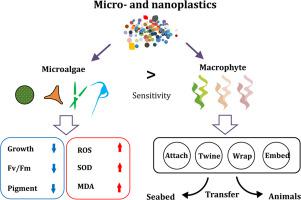Journal of Hazardous Materials ( IF 13.6 ) Pub Date : 2020-11-27 , DOI: 10.1016/j.jhazmat.2020.124685 Guang Gao , Xin Zhao , Peng Jin , Kunshan Gao , John Beardall

|
The impacts of micro- and nanoplastics (MNPs) on aquatic animals have been intensively studied; however, the extent and magnitude of potential effects of MNPs on aquatic primary producers are poorly understood. In this study, we quantitatively analyzed the published literature to examine the impacts of MNPs on growth, photosynthesis, pigments, and metabolism of aquatic microalgae. MNPs negatively affected growth of microalgae but usually had a high EC50 (> 25 mg/L). However, positively charged MNPs had a much lower EC50 (<1 mg/L). MNPs lowered maximum photochemical efficiency of photosystem II (Fv/Fm) with the effect increasing with concentration of MNPs but diminishing with exposure time, and also reduced chlorophyll a content to enhanced extent with increased MNPs concentration. MNPs induced relatively higher changes in superoxide dismutase (SOD) and malondialdehyde (MDA) levels in marine algae than in freshwater algae. Reactive oxygen species (ROS) levels increased with MNPs concentration and exposure time while SOD levels first increased and then decreased with increasing MNPs concentration. Macrophytes were found to be able to trap MNPs via multiple mechanisms. Future work should focus on the mechanisms behind MNPs impacts on primary productivity and global carbon cycle, and the combined effects of MNPs with other environmental factors.
中文翻译:

在微米和纳米塑料水平不断提高的世界中,水生初级生产者当前的认识和挑战
微米和纳米塑料(MNPs)对水生动物的影响已得到深入研究。然而,人们对MNP对水生初级生产者的潜在影响的程度和程度了解甚少。在这项研究中,我们定量分析了已发表的文献,以检查MNP对水生微藻的生长,光合作用,色素和代谢的影响。MNP对微藻的生长产生不利影响,但通常具有较高的EC 50(> 25 mg / L)。但是,带正电荷的MNP的EC 50值要低得多(<1 mg / L)。MNPs降低了光系统II的最大光化学效率(F v / F m),其效果随着MNPs浓度的增加而增加,但随着暴露时间的延长而减小,并且还降低了叶绿素aMNPs浓度增加,含量增加。MNPs引起的藻类中超氧化物歧化酶(SOD)和丙二醛(MDA)含量的变化要比淡水藻类中的变化相对较高。活性氧(ROS)水平随MNPs浓度和暴露时间的增加而增加,而SOD含量则先随MNPs浓度的增加而增加,然后下降。发现大型植物能够通过多种机制捕获MNP。未来的工作应侧重于MNP对初级生产力和全球碳循环的影响背后的机制,以及MNP与其他环境因素的综合影响。



























 京公网安备 11010802027423号
京公网安备 11010802027423号